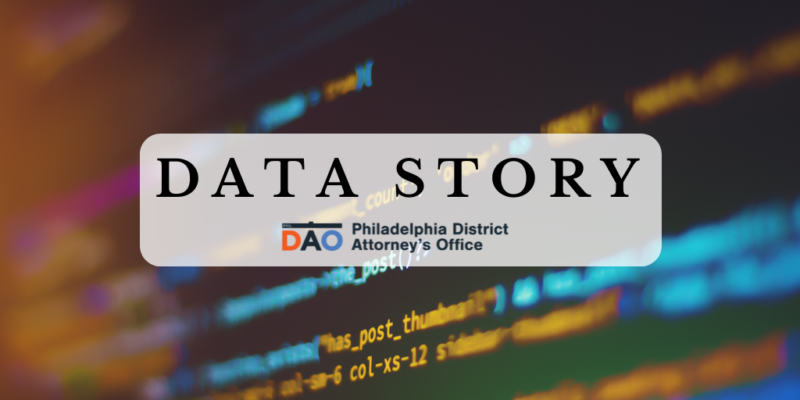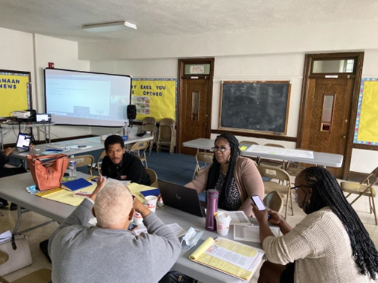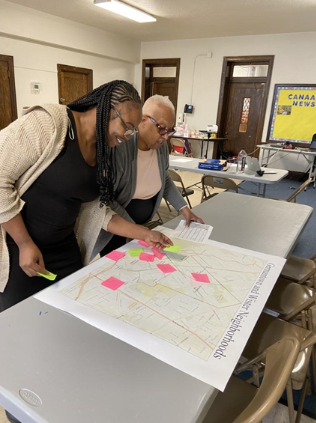
By: Christion Smith (GIS & Data Analyst, DATA Lab)
Note: This data story comes out of work with a community partner, Every Murder Is Real (EMIR) Healing Center, and would not have been possible without their partnership and support. We thank them for their collaboration on this and other new initiatives, and for allowing us to use the photographs included in this data story.
Introduction
If a picture is worth a thousand words, then a map is worth two thousand. Maps convey more information than written text, allowing for more complex portrayals of spatial patterns. People have personal connections to maps and how they convey information about the places and communities they care about. As researchers and data analysts working in a law enforcement government agency, one of our primary responsibilities is to distill data into practical insights for practitioners and a range of decision-makers to help inform decisions. Maps are one of the key visualization tools we use to depict and chronicle the adverse effects of the criminal legal system on communities in Philadelphia.
In the same way we use data and maps to depict the harms of the criminal legal system, we can use it to highlight the positive qualities of communities, including those most impacted by community violence and system contact. Dominant narratives in media and academia often over-emphasize problems or negative attributes within communities, neglecting stories of resourcefulness and resilience within certain neighborhoods. All communities have assets and strengths within them that they can leverage to alleviate some of the problems that they are experiencing, but community assets are often underutilized due to lack of awareness.
Asset mapping is one way to draw attention to these existing assets and build awareness, capacity, and social cohesion around them. Taking a community strength- and asset-based approach is essential to creating policies and interventions that will positively affect that neighborhood. Rather than impose perspectives from external stakeholders, proposed solutions should build on communities’ existing positive qualities. The DAO is applying this asset–based lens through the efforts of the District Attorney’s Transparency and Analytics (DATA) Lab. The DATA Lab has participated in several community asset mapping sessions, an effort that we are extending in the coming years through a Pennsylvania Commission on Crime and Delinquency (PCCD) grant. Read more about DATA Lab’s community-engaged program, the Data CoLab.
What is Asset Mapping?
Asset mapping is a community-engaged process that identifies the strengths and resources within a community and charts them geographically. A cornerstone of the social work approach, asset mapping is often used in the context of community development and planning. Increasingly, agencies seeking to reform criminal justice policy are using asset mapping to maximize the positive impact of changes and interventions.
To be effective, asset mapping must be done in active partnership and participation with members of the relevant communities. Community-participatory asset mapping usually involves a group activity where community members come together around a particular question or need, then collectively think through and document resources in their immediate community that can address the question or need.
Identified resources can then be placed on an enlarged map where the locations of these resources can be viewed in relation to one another. Laying out the information in this way allows new patterns to emerge and helps stakeholders envision stronger solutions. Asset maps can also become community resources themselves, and can be distilled and distributed in ways that help raise awareness and bring greater benefit to residents.
Takeaways From Past Asset Mapping Workshops
In 2022, the DATA Lab conducted an asset mapping workshop with a Germantown-based community organization, Every Murder Is Real (EMIR) Healing Center. EMIR “enables healing from trauma and grief through support and education” by “provid[ing] services and support to family members and friends who have been affected by homicide because Every Murder is Real.” Chantay Love, MHSA, CSM, is the Co-Founder and President of EMIR Healing Center, which “stands as a beacon of hope” honoring her brother, Emir, a homicide victim. The asset mapping workshop was the third in a series of workshops that included How Data Can Enhance Organizing and Advocacy Work and Your Community Story. These workshops built upon each other and helped develop rapport with the community organization in order to cultivate an environment suitable for them to share their knowledge and lift up assets. The event drew 18 participants, 6 in-person and 12 joining virtually. The workshop emphasized active participation and collective brainstorming.

EMIR staff work collectively to brainstorm and discuss assets in Germantown.
After a joint introduction, the workshop transitioned into two groups (in-person and virtual). Together, both groups generated a total of 27 assets representing a variety of resources that included: 6 parks/recreation, 4 religious institutions, 4 schools, 3 centers for culture, 2 government institutions, 2 non-profits, 1 childcare facility, 1 government representative, 1 grocery store, 1 health center, 1 library, and 1 shopping center.
After both groups documented known resources, the in-person group marked locations on enlarged paper maps (see picture). The resources were later documented in a spreadsheet and were used to create static and interactive online map products for the community organization to use and share with others.

EMIR staff mapping their identified resources on an enlarged map.
Takeaway #1 – A Hybrid Workshop Has Advantages and Disadvantages
There are numerous advantages to offering a virtual option for an asset mapping workshop. It allows more people to attend and receive or impart valuable information, including people who may have otherwise been prevented from attending due to illness or accessibility issues. Online mapping tools can also be used to increase participation or innovation, and can result in the rapid, collaborative creation of sharable community materials.
There are also several challenges to offering a virtual option for a mapping workshop. An inadequate microphone prevented participants from hearing each other, and time was spent moving the microphone or repeating participant comments. While the in-person and virtual groups were able to come together and share the results of their independent work, each had materially different experiences with the activity. Conducting asset mapping in-person allows for the physical placement of assets on a paper map, an immersive experience that may enhance connection to the activity concepts.
Takeaway #2 – Leave Plenty of Time for Discussion
Participants were very engaged in collective brainstorming and mapping, leaving little time for the planned final discussion. However, this step is necessary for the integrative process, allowing participants to better internalize and digest the knowledge that was produced through the activity and workshop. When planning an agenda for community asset mapping, it is important to set realistic time goals and stick to them as much as possible, or to schedule follow-up sessions as time and capacity allow. One reason we are so excited about the PCCD-funded Data CoLab is that it will allow us to have dedicated resources and personnel supporting community partners and efforts including asset mapping.
Takeaway #3 – The Findings Are for the Community
Asset mapping is grounded in social work and community development practices but is increasingly recognized as a valuable data tool that can benefit communities more than traditional research approaches. A hallmark of the Community-Based Participatory Research (CBPR) approach and toolkit, asset maps are intended to be resources created in collaboration with community and immediately shared back. Traditional research often involves one-sided surveys, the results of which are then published in journals and not reported back to participants. A CPBR approach avoids this by working directly alongside the community at each research stage to ensure that findings are integrated and available to the people and places that provided the data. Examples of directly beneficial products that can come from asset mapping for any community are a fresh food map, a youth resources map, and a public bathroom map.
Looking Ahead
This valuable experience with asset mapping and other community-engaged efforts led the Philadelphia DAO and DATA Lab to pursue a grant with the Pennsylvania Commission on Crime & Delinquency (PCCD). The $1.77 million award—which includes over $500,000 in funding for community partners—enables us to formalize and expand these initiatives, which are now housed under a new community-collaborative program, the Data CoLab. The grant provides funding for a team including a project manager, project coordinators, and a geographic information systems (GIS) analyst who will work alongside DATA Lab personnel to support the work and needs of partners. The Data CoLab will work with 8 community partners in 4 neighborhoods throughout the city to support the neccesary work of our community partners and further build community capacity from a knowledge-sharing and data-driven approach. We are proud to have EMIR as one of our CoLab partners, and look forward to more asset mapping together this fall. It is important to update the maps regularly as the community is a living and breathing space that is ever changing, so for this resource to be effective it needs to be up to date. Accordingly, beyond hosting such workshops, part of the model includes providing resources so community organizations can lead these types of sessions.
Asset maps are an emergent tool communities can use to build capacity, raise awareness of resources, and increase social cohesion. Our efforts suggest that criminal legal and government agencies can successfully engage in these practices to support community-based partners and identify existing community strengths in order to better address needs and combat stigma that is often associated with deficit-based approaches. Please email [email protected] or [email protected] with any questions. We are excited for the future of this collaborative work.